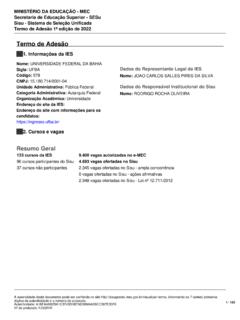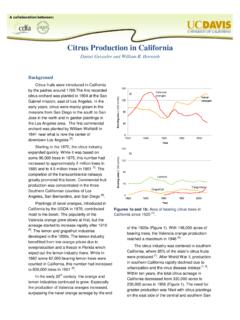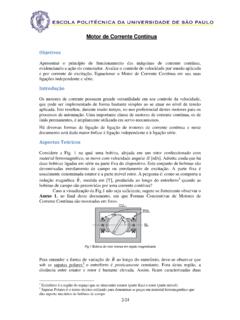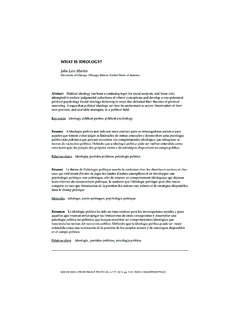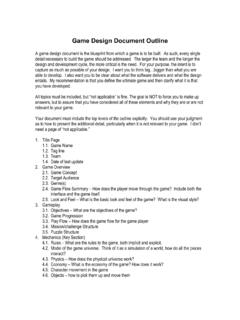Transcription of Abnormalities of Teeth - University of Missouri–Kansas City
1 " Abnormalities of Teeth " 1 Charles Dunlap, DDSSept. 2004 CONTENTST here are many acquired and inherited developmental Abnormalities that alter the size, shape and number of Teeth . Individ-ually, they are rare but collectively they form a body of knowledge with which all dentists should be familiar. The discus-sion of each condition is short and to the point. Comprehensive reviews of each may be found in any reasonably new text-book of oral pathology. For those conditions that are inherited (eg: ectodermal dysplasia, dentinogenesis imperfecta andothers) go to: ,it will bookmark as OMIM (Online Mendelian Inheritance in Man).Supernumerary TeethSlide #1 is an example of an extra incisor. When located in the midline between the two permanent central incisors, theyare referred to as mesiodens.
2 Slide #2 depicts an extra molar tooth (a paramolar) and Slide #3 is an example of a super-numerary bicuspid tooth. These are the most common supernumerary Teeth in the order 1: mesiodensSlide 2: fourth molarSlide 3: supernumerary bicuspidHyperdontia and Cleidocranial dysplasiaCount the Teeth in Slide #4 there are more than 50. This patient has cleidocranial dysplasia (CCD). This is inheritedas an autosomal dominant trait, the gene maps to chromosome #6. The gene encodes a protein called Core Binding Fac-tor Alpha 1 (CBFA1). This protein is essential for the formation of a normal skeleton but its role in tooth formation isnot yet known. The heterozygous state produces the CCD phenotype, the homozygous state is lethal. Main features ofthe phenotype include hyperdontia, small or missing clavicles, delayed closure of the cranial fontanelles (soft spots) andshort stature.
3 Slide #5 shows multiple supernumerary Teeth removed from a patient with CCD. Gardner syndrome (intes-tinal polyposis and skeletal osteomas) also features supernumerary Teeth but not to the extent seen in CCD. ( J. 1999;36 p177-182 and Cell 89; 773-779 May 1997)Slide #6 is a little tricky. The coin shape radiolucent lesion between the mandibular bicuspid Teeth was thought to be a was removed and found to be a tooth germ of a developing supernumerary tooth. It was discovered early in developmentbefore mineralization commenced. Radiographically, it resembles a lateral periodontal cyst. Slide 4: cleidocranial dysplasiaSlide 5: cleidocranial dysplasiaSlide 6: supernumerary tooth germSupernumerary Teeth .. 1 Hyperdontia and Cleidocranial Dysplasia .. 1 Hypodontia , Oligodontia and Ectodermal Dysplasia.
4 2 Taurodontism .. 3 Fusion, Gemination, Dilaceration and Concrescence .. 3 Hypercementosis, Screwdriver incisors and Mulberry molars .. 4 Macrodontia , Dens in dente, & Enamelomas .. 4 Attrition, Erosion and Abrasion .. 5 Internal and External Resorption.. 6 Dentinogenesis Imperfecta , types I, II, & III .. 7 Dentin Dysplasia, types I & II.. 8 Regional Odontodysplasia.. 8 Segmental Odontomaxillary Dysplasia .. 9 Amelogenesis Imperfecta .. 9 Self-Exam Cases .. 10 ABNORMALITES OFTEETHH ypodontia and OligodontiaGlossary: Anodontia: failure of Teeth to develop (same as agenesis of Teeth )Hypodontia: having less than 6 congenitally missing Teeth . (partial anodontia)Oligodontia: having 6 or more congenitally missing : extra Teeth , same as supernumerary Teeth , may be singleor multiple as in CCD.
5 (*To see how the web site OMIM works, log on and enter hypodontia.)Congenitally missing Teeth (hypodontia and oligodontia) are not rare. Generationsof dental students have learned about ectodermal dysplasia, the best know of the missing Teeth syndromes. With the discovery of the Pax 9 gene, some light hasbeen shed on the molecular genetics of congenitally missing Teeth . Pax 9 maps tochromosome #14, it encodes a transcription factor that functions in the develop-ment of derivatives of the pharyngeal pouches. Mice with Pax 9 mutations have craniofacial and limb anomalies and Teeth fail to form beyond the bud stage . Afamily with a framshift mutation in Pax 9 had normal deciduous Teeth but lackedpermanent molars in both the maxilla and mandible.
6 It is transmitted as a dominanttrait. (Nature Genetics 24;18-19 2000 Jan , also European Journal of Oral Sciences106; 38-43 1998)The best known of the missing Teeth syndromes is X-linked hypohidrotic ectoder-mal dysplasia. Ectodermal derivatives such as hair, sweat glands, nails and Teeth areinvolved. Head hair, eye lashes and brows are sparse, nails are dystrophic and thereis marked oligodontia, rarely total anodontia. Diminished sweat glands leads to theinability to regulate body temperature, a major disability in warm months in a hotclimate. According to your text ( Neville s Oral & Maxillofacial Pathology 2nd ed),there are 150 variants of this syndrome. Dominant, recessive and X-linked inheri-tance have been reported. Slide #7 shows the mildest form of hypodontia, a single congenitally missing tooth,in this case a bicuspid.
7 Notice the deciduous molar has been retained. Slide #8 illus-trates the other extreme, a 10 year old child missing virtually all permanent teethexcept 1st molars. Slides #9 and #10 are of a child with ectodermal dysplasia. Thereis profound oligodontia and Teeth that are present are cone shaped. Note the sparsescalp hair, brows and lashes. (Remember X-linked disease are milder in femalesbecause they enjoy partial protection thanks to lyonization.)We will exit the subject of hypodontia/oligodontia by looking at Slide #11, anexample of a cone-shaped lateral incisor, a peg lateral, a form of microdontia. Thismay be inherited as a dominant trait. If both parents have peg laterals , thehomozygous child will have total anodontia of succedaneous Teeth .
8 (Am. J. or 26:431-436 1987)Slide 7: congenitally missing bicuspidSlide 10: ectodermal dysplasiaSlide 11: microdontia or "peg lateral"Slide 8: oligodontiaSlide 9: ectodermal dysplasia" Abnormalities of Teeth " 2 Charles Dunlap, DDSSept. 2004" Abnormalities of Teeth " 3 Charles Dunlap, DDSSept. 2004 Taurodontism A morphologic abnormality of Teeth called taurodontism (bull Teeth ) is seen in slide #12. Slide #13 is a normal cynodontfor comparison. Slide #14 is also a taurodont. This condition is most conspicuous in the molar Teeth . The distance fromthe roof of the pulp chamber to the root bifurcation is greatly increased. Variants include hypotaurodontism, mesotau-rodontism and hypertaurodontism. Cases illustrated here are hypertaurodonts. This conditions may exist as an isolatedtrait (autosomal dominant) or as part of several syndromes including the trichodentoosseous syndrome (TDO), otodentaldysplasia, ectodermal dysplasia, tooth and nail syndrome, amelogenesis imperfecta and others.
9 (Am. J. Med. Genetics11; 435-442 1982 April). Visit OMIM for 12: taurodontSlide 13: cynodont (normal)Slide 14: taurodontFusion, Gemination, Dilacertion & ConcrescenceThese conditions are illustrated in Slides #15 through #27and require little , the joining of two adjacent tooth germs to form asingle large tooth is seen in Slide #15. Notice the lateralincisor is missing, it fused with the central , an attempt by a single tooth germ to formtwo , seen in Slides #16 and #17.* It is notalways readily apparent if a large tooth is an example offusion or germination. If you have a problem, just countthe Teeth . If one is missing it is fusion, if one is not miss-ing, it is #18, dilaceration, an abnormal deviation (bend) inthe root of a tooth, presumably caused by traumatic dis-placement during root # 19 is an example of concrescence, the fusion of cementum of adjacent Teeth ,a good reason to have radiographs before extraction of a 18: dilaceration Slide 19: concrescence Slide 17: germinationof both central incisorsSlide 15: fusionSlide 16: gemination " Abnormalities of Teeth " 4 Charles Dunlap, DDSSept.
10 2004 Hypercementosis, screwdriver incisors and mulberry molars:Hypercementosis is seen in Slides #20 and #21. Note the thick mantle of cementum that makes the root look fat. (a nation-al board pearl: If the jaws are involved in Paget disease of the skeleton (osteitis deformans), the Teeth may show hyperce-mentosis. But in practice, Paget disease seldom involves the jaws. Somewhere long ago in a faraway place, a case ofosteitis deformans of the jaws with hypercementosis was reported and has endured in dental literature.) Slides #22 and#23 also show dental defects that have endured in dental literature but have virtually disappeared in practice. They illus-trate Screwdriver incisors and Mulberry molars , dental defects seen in congenital syphilis and caused by direct inva-sion of tooth germs by Treponema organisms (yes, Treponema pallidum can pass through the placenta).

